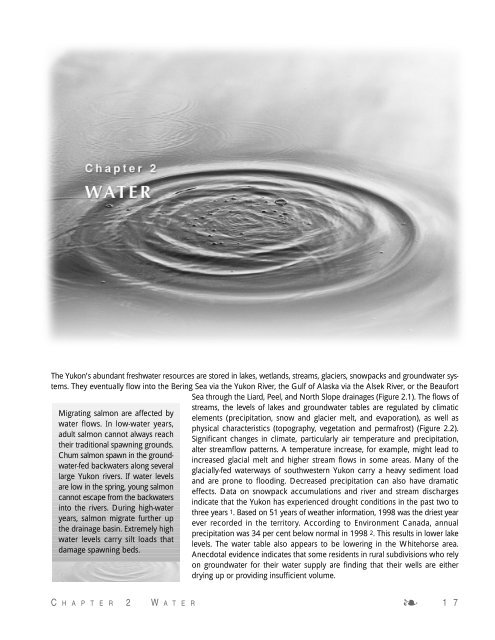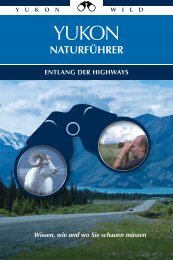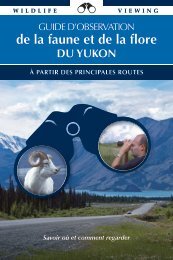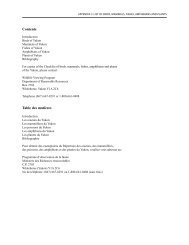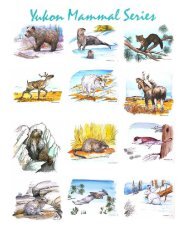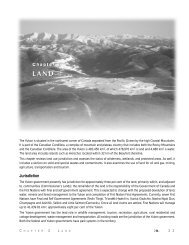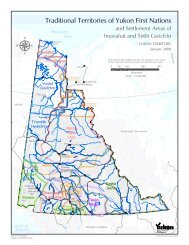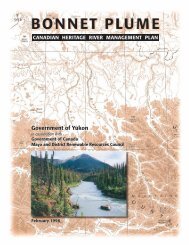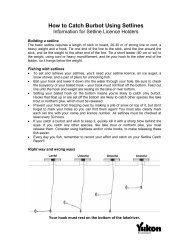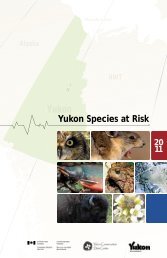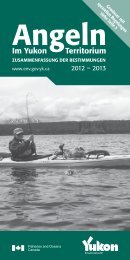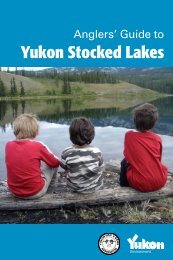The Yukon's abundant freshwater resources are stored in lakes ...
The Yukon's abundant freshwater resources are stored in lakes ...
The Yukon's abundant freshwater resources are stored in lakes ...
You also want an ePaper? Increase the reach of your titles
YUMPU automatically turns print PDFs into web optimized ePapers that Google loves.
<strong>The</strong> Yukon’s <strong>abundant</strong> <strong>freshwater</strong> <strong>resources</strong> <strong>are</strong> <strong>stored</strong> <strong>in</strong> <strong>lakes</strong>, wetlands, streams, glaciers, snowpacks and groundwater systems.<br />
<strong>The</strong>y eventually flow <strong>in</strong>to the Ber<strong>in</strong>g Sea via the Yukon River, the Gulf of Alaska via the Alsek River, or the Beaufort<br />
Sea through the Liard, Peel, and North Slope dra<strong>in</strong>ages (Figure 2.1). <strong>The</strong> flows of<br />
Migrat<strong>in</strong>g salmon <strong>are</strong> affected by<br />
water flows. In low-water years,<br />
adult salmon cannot always reach<br />
their traditional spawn<strong>in</strong>g grounds.<br />
Chum salmon spawn <strong>in</strong> the groundwater-fed<br />
backwaters along several<br />
large Yukon rivers. If water levels<br />
<strong>are</strong> low <strong>in</strong> the spr<strong>in</strong>g, young salmon<br />
cannot escape from the backwaters<br />
<strong>in</strong>to the rivers. Dur<strong>in</strong>g high-water<br />
years, salmon migrate further up<br />
the dra<strong>in</strong>age bas<strong>in</strong>. Extremely high<br />
water levels carry silt loads that<br />
damage spawn<strong>in</strong>g beds.<br />
streams, the levels of <strong>lakes</strong> and groundwater tables <strong>are</strong> regulated by climatic<br />
elements (precipitation, snow and glacier melt, and evaporation), as well as<br />
physical characteristics (topography, vegetation and permafrost) (Figure 2.2).<br />
Significant changes <strong>in</strong> climate, particularly air temperature and precipitation,<br />
alter streamflow patterns. A temperature <strong>in</strong>crease, for example, might lead to<br />
<strong>in</strong>creased glacial melt and higher stream flows <strong>in</strong> some <strong>are</strong>as. Many of the<br />
glacially-fed waterways of southwestern Yukon carry a heavy sediment load<br />
and <strong>are</strong> prone to flood<strong>in</strong>g. Decreased precipitation can also have dramatic<br />
effects. Data on snowpack accumulations and river and stream discharges<br />
<strong>in</strong>dicate that the Yukon has experienced drought conditions <strong>in</strong> the past two to<br />
three years 1. Based on 51 years of weather <strong>in</strong>formation, 1998 was the driest year<br />
ever recorded <strong>in</strong> the territory. Accord<strong>in</strong>g to Environment Canada, annual<br />
precipitation was 34 per cent below normal <strong>in</strong> 1998 2. This results <strong>in</strong> lower lake<br />
levels. <strong>The</strong> water table also appears to be lower<strong>in</strong>g <strong>in</strong> the Whitehorse <strong>are</strong>a.<br />
Anecdotal evidence <strong>in</strong>dicates that some residents <strong>in</strong> rural subdivisions who rely<br />
on groundwater for their water supply <strong>are</strong> f<strong>in</strong>d<strong>in</strong>g that their wells <strong>are</strong> either<br />
dry<strong>in</strong>g up or provid<strong>in</strong>g <strong>in</strong>sufficient volume.<br />
C H A P T E R 2 W A T E R ❧ 1 7
Long-term monthly average flows of<br />
the Yukon River at Whitehorse,<br />
Carmacks and Dawson <strong>are</strong> shown <strong>in</strong><br />
Figure 2.3. For all three sites, the lowest<br />
flow occurs <strong>in</strong> late w<strong>in</strong>ter as the <strong>in</strong>puts<br />
decrease and freeze, and the ice thickness<br />
of the river’s surface <strong>in</strong>creases (up<br />
to two metres thick at some locations).<br />
<strong>The</strong> stream flow dur<strong>in</strong>g this time is<br />
composed ma<strong>in</strong>ly of groundwater.<br />
Figure 2.2 <strong>The</strong> Water Cycle<br />
Water is <strong>stored</strong> <strong>in</strong> <strong>lakes</strong>, streams, snowpacks, glaciers and underground aquifers, It enters<br />
the atmosphere by evaporation from the surfaces of water and land, or from transpiration<br />
by plants. Most ra<strong>in</strong> clouds <strong>in</strong> the Yukon come <strong>in</strong> from the Gulf of Alaska or from the<br />
Beaufort Sea. When moisture condenses <strong>in</strong> the atmosphere, it returns to the earth as ra<strong>in</strong><br />
or snow. On the earth’s surface, water flows <strong>in</strong>to streams or percolates through aquifers<br />
as groundwater.<br />
Figure 2.1 Dra<strong>in</strong>age Bas<strong>in</strong>s of the Yukon<br />
Spr<strong>in</strong>g melt<strong>in</strong>g br<strong>in</strong>gs a rapid <strong>in</strong>crease<br />
<strong>in</strong> flow. Peak flow at Carmacks and<br />
Dawson occurs <strong>in</strong> early June, whereas<br />
glacial melt from the Yukon’s headwaters<br />
keeps water levels high <strong>in</strong><br />
Whitehorse throughout the summer,<br />
often peak<strong>in</strong>g <strong>in</strong> late August or early<br />
September.<br />
<strong>The</strong> abundance of fresh water is locally<br />
affected by human activity such as the<br />
withdrawal, diversion, or storage of<br />
water for <strong>in</strong>dustrial, hydroelectric<br />
generation or domestic use. Although<br />
demands on Yukon surface waters have<br />
not resulted <strong>in</strong> the major disruptions of<br />
natural flows experienced <strong>in</strong> many<br />
<strong>are</strong>as, hydroelectric development and<br />
m<strong>in</strong><strong>in</strong>g have altered flow patterns <strong>in</strong><br />
some locations. Hydroelectric generation<br />
depends on water availability.<br />
When water flows <strong>are</strong> low, we become<br />
more dependent on diesel fuel for the<br />
generation of electricity. When water<br />
levels <strong>are</strong> abnormally high, flood<strong>in</strong>g<br />
can occur <strong>in</strong> storage reservoirs.<br />
1 8 ❧ Y U K O N S T A T E O F T H E E N V I R O N M E N T R E P O R T 1999<br />
April 26
2.1 Water Allocation and Use<br />
Measur<strong>in</strong>g Stream Flow<br />
<strong>The</strong> <strong>in</strong>formation provided by the<br />
hydrometric monitor<strong>in</strong>g network is<br />
used to estimate water availability for<br />
<strong>in</strong>dustry and hydroelectric generation,<br />
to forecast flood<strong>in</strong>g, to design culverts<br />
and bridges, and to determ<strong>in</strong>e water<br />
levels for river navigation. Streamflow<br />
<strong>in</strong>formation is also used to predict<br />
levels of contam<strong>in</strong>ants <strong>in</strong> water bodies<br />
downstream from proposed <strong>in</strong>dustrial<br />
developments and to monitor long-term<br />
environmental change.<br />
A territory-wide network of permanent<br />
hydrometric (water measur<strong>in</strong>g) stations<br />
is ma<strong>in</strong>ta<strong>in</strong>ed by Environment Canada.<br />
In 1995, there were 70 stations<br />
monitored year round; by 1999, the<br />
number of stations was reduced to 48.<br />
<strong>The</strong> Department of Indian Affairs and<br />
Northern Development (DIAND) also<br />
operates a network of hydrometric<br />
stations on small streams dur<strong>in</strong>g open<br />
water months. <strong>The</strong>re were 16 stations<br />
<strong>in</strong> 1998. Two more sites were added <strong>in</strong><br />
1999 for monitor<strong>in</strong>g dur<strong>in</strong>g 1999 open<br />
water season (Figure 2.4).<br />
Groundwater<br />
Not much is known about the quality<br />
or quantity of Yukon groundwater<br />
aquifers. A proposal by DIAND to set<br />
up a groundwater database <strong>in</strong> Ottawa<br />
to provide <strong>in</strong>formation on municipal<br />
wells <strong>in</strong> the Yukon and Northwest<br />
Territories has not yet been<br />
implemented 3. A groundwater study is<br />
proposed for late 1999 early 2000 to<br />
monitor and evaluate groundwater<br />
conditions <strong>in</strong> the Whitehorse <strong>are</strong>a 4.<br />
Groundwater wells, often <strong>in</strong>stalled near<br />
tail<strong>in</strong>gs ponds of m<strong>in</strong>es and domestic<br />
sewage lagoons to monitor effects on<br />
the quality of the immediate groundwater,<br />
provide localized <strong>in</strong>formation.<br />
A valuable groundwater resource is<br />
the Selkirk Street aquifer which<br />
provides almost 30 per cent of the<br />
water used <strong>in</strong> the City of Whitehorse<br />
(based on 1997 data). Although<br />
aquifers provide good quality dr<strong>in</strong>k<strong>in</strong>g<br />
water, their most important features<br />
<strong>are</strong> the thermal properties provided<br />
flow (cubic metres per second)<br />
7000<br />
6000<br />
5000<br />
4000<br />
3000<br />
2000<br />
1000<br />
0<br />
Jan<br />
Feb<br />
Mar<br />
Apr<br />
May<br />
June<br />
by groundwater. A good portion of the<br />
water <strong>in</strong> the Selkirk Street aquifer is<br />
used <strong>in</strong> bleeder systems dur<strong>in</strong>g the<br />
w<strong>in</strong>ter months and requires no further<br />
heat<strong>in</strong>g.<br />
Dawson<br />
Carmacks<br />
Whitehorse<br />
Figure 2.3 Long-term monthly average flows of the Yukon River at Whitehorse<br />
(1943-1998), Carmacks (1951-1995), and Dawson City (1945-1980)<br />
<strong>The</strong> volume of water <strong>in</strong> the Yukon River <strong>in</strong>creases mov<strong>in</strong>g downstream from Whitehorse<br />
to Dawson City: <strong>The</strong> peak flow at Dawson City <strong>in</strong> June results from the melt<strong>in</strong>g snow<br />
pack <strong>in</strong> the <strong>in</strong>terior.<br />
Firth River<br />
Old Crow River<br />
Ogilvie River<br />
Yukon River<br />
Alsek River<br />
Blow River<br />
Porcup<strong>in</strong>e River<br />
Klondike River<br />
Stewart River<br />
Ashihik River<br />
Hart River<br />
McQuesten River<br />
Yukon River<br />
Peel River<br />
W<strong>in</strong>d River<br />
Bonnet Plume River<br />
Pelly River<br />
Stewart River<br />
Macmillan River<br />
Big Salmon<br />
River<br />
Tesl<strong>in</strong> River<br />
Snake River<br />
1999<br />
Ross River<br />
Liard River<br />
Frances River<br />
July<br />
Aug<br />
Sept<br />
1995<br />
Oct<br />
Active Sites<br />
Figure 2.4 Water Hydrology Sites, 1995 and 1999<br />
Due to budget constra<strong>in</strong>ts, the number of sites monitored for flow have decreased<br />
s<strong>in</strong>ce 1995.<br />
Nov<br />
Dec<br />
C H A P T E R 2 W A T E R ❧ 1 9
Dr<strong>in</strong>k<strong>in</strong>g water supplied by groundwater<br />
<strong>in</strong> Carcross was the subject of<br />
concern <strong>in</strong> the mid-1980s. Wellwater<br />
test<strong>in</strong>g <strong>in</strong>dicated that arsenic, a naturally<br />
occurr<strong>in</strong>g poisonous element, was<br />
show<strong>in</strong>g up <strong>in</strong> samples at levels<br />
Is the Yukon’s Water for Export?<br />
approach<strong>in</strong>g the unacceptable limit for<br />
dr<strong>in</strong>k<strong>in</strong>g water (over 0.05 parts per<br />
million). Steps were taken to bypass<br />
the groundwater source and supplies<br />
<strong>are</strong> now obta<strong>in</strong>ed from an <strong>in</strong>take <strong>in</strong><br />
Lake Bennett.<br />
In 1947, the Alum<strong>in</strong>ium Company of America expressed <strong>in</strong>terest <strong>in</strong> divert<strong>in</strong>g<br />
the headwaters of the Yukon River through the Coast Mounta<strong>in</strong>s and<br />
<strong>in</strong>to the Taiga River for power generation at Pacific tide-water <strong>in</strong> Alaska.<br />
An agreement between Canada and the United States resulted <strong>in</strong> the Yukon<br />
Power and Storage Investigation. <strong>The</strong> proposal was eventually rejected by<br />
the Government of Canada <strong>in</strong> 1952. Later <strong>in</strong> the 1950s, Northwest Power<br />
Industries announced plans for a $270 million power development on the<br />
Yukon-British Columbia border, known as the Yukon-Taku Project. Design<br />
work was to beg<strong>in</strong> <strong>in</strong> 1957, but this plan was resc<strong>in</strong>ded.<br />
<strong>The</strong> economic potential from sell<strong>in</strong>g the Yukon’s seem<strong>in</strong>gly limitless fresh<br />
water was not forgotten. A proposal <strong>in</strong> 1964 by the North American Water<br />
and Power Alliance called for divert<strong>in</strong>g flows from the Yukon River<br />
headwaters southward through the Rocky Mounta<strong>in</strong> Trench <strong>in</strong>to the United<br />
States and Mexico to provide water for irrigation and generat<strong>in</strong>g electricity.<br />
This proposal was eventually stalled due to social, environmental, economic<br />
and political opposition.<br />
Large-scale diversion of the Yukon’s surface water does not appear probable<br />
<strong>in</strong> the near future. Although there is a proposed nation-wide moratorium of<br />
bulk export of water, there is no federal legislation that deals specifically<br />
with water exports. Bulk water exports do not <strong>in</strong>clude bottled water.<br />
However, the federal government has considerable control over the Yukon’s<br />
surface waters. <strong>The</strong> Fisheries Act has broad powers to control alterations <strong>in</strong><br />
waterways that support fisheries. Approval under the Navigable Waters<br />
Protection Act would also be required for alterations to larger water courses<br />
like the Yukon River. Also, <strong>in</strong>ternational rivers such as the Yukon River <strong>are</strong><br />
regulated under the International Rivers Improvement Act.<br />
Both British Columbia and Alberta have legislation that prohibits the<br />
removal of bulk water, <strong>in</strong>clud<strong>in</strong>g for export. <strong>The</strong> devolution of the<br />
management of water from the federal government to the Yukon<br />
government is to occur <strong>in</strong> the year 2001, and there may be an opportunity<br />
to create similar legislation to protect the territory’s fresh water resource.<br />
“We know that s<strong>in</strong>gle and cumulative bulk removals of fresh water can have serious<br />
impacts on the environmental, social and economic health of communities and<br />
ecosystems that depend on these watersheds. I will be seek<strong>in</strong>g agreement on a<br />
Canada-wide accord for the prohibition of bulk water removal from all of Canada’s<br />
major watersheds when I meet with my prov<strong>in</strong>cial and territorial colleagues later this<br />
month. This is an environmental issue to be decided by Canadians. We will stop bulk<br />
removals at the source not at the border.”<br />
Environment M<strong>in</strong>ister David Anderson News Release, November 22, 1999<br />
Allocat<strong>in</strong>g Water<br />
Two types of water demands <strong>are</strong> <strong>in</strong>stream<br />
uses and water withdrawals. Instream<br />
uses <strong>in</strong>clude fish and wildlife,<br />
navigation, and recreation. Water<br />
withdrawals <strong>are</strong> uses that remove water<br />
from streams or <strong>lakes</strong> for domestic,<br />
municipal, agricultural or <strong>in</strong>dustrial<br />
purposes. Withdrawals can alter stream<br />
flows and water levels, thereby affect<strong>in</strong>g<br />
the supply of water for <strong>in</strong>-stream uses.<br />
<strong>The</strong> allocation of water withdrawals<br />
(surface water and groundwater) to<br />
<strong>in</strong>dustrial users and municipalities is<br />
shown <strong>in</strong> Figure 2.5. Data <strong>are</strong> based on<br />
the amount of water <strong>in</strong>dividuals or<br />
companies <strong>are</strong> allowed to withdraw<br />
accord<strong>in</strong>g to their water licences 5.<br />
Some users cannot use water all year<br />
so a few assumptions have been made<br />
<strong>in</strong> compil<strong>in</strong>g data for this graph. Water<br />
allocation for placer m<strong>in</strong><strong>in</strong>g and<br />
agriculture was based on an average<br />
season of 110 days and a 12-hour<br />
work<strong>in</strong>g day. Hydroelectric use is not<br />
shown here because water is not<br />
withdrawn. Entire rivers <strong>are</strong> slowed<br />
down <strong>in</strong> storage reservoirs and then<br />
passed through turb<strong>in</strong>es and spillways.<br />
In general, the same amount of water is<br />
returned and its quality is basically<br />
unchanged. In municipal and <strong>in</strong>dustrial<br />
uses however, the water is removed,<br />
used, and some or all of it is returned to<br />
the stream, usually <strong>in</strong> an altered state.<br />
Municipal (75.4%)<br />
Placer M<strong>in</strong><strong>in</strong>g (12.6%)<br />
Conservation (6.9%)<br />
Other (2.1%)<br />
Hardrock M<strong>in</strong><strong>in</strong>g (2.1%)<br />
Agriculture (0.9%)<br />
Figure 2.5 Water Allocation by<br />
Sector, 1998<br />
Both sectors of m<strong>in</strong><strong>in</strong>g, hardrock and<br />
placer, were down significantly <strong>in</strong> 1998.<br />
This is reflected <strong>in</strong> their water use.<br />
2 0 ❧ Y U K O N S T A T E O F T H E E N V I R O N M E N T R E P O R T 1999<br />
April 26
Domestic Water Use<br />
Total water use with<strong>in</strong> the City of<br />
Whitehorse for 1998 was 5,674,557<br />
cubic metres for a population of<br />
23,406, represent<strong>in</strong>g 842 litres per<br />
person per day. This comp<strong>are</strong>s to the<br />
1996 national average of 326 litres per<br />
person per day (Figure 2.6) 6. <strong>The</strong><br />
Whitehorse personal consumption<br />
figure is a bit mislead<strong>in</strong>g as a substantial<br />
amount of water is lost to leakage, and<br />
a considerable amount of water is used<br />
<strong>in</strong> bleeder systems to prevent pipes<br />
from freez<strong>in</strong>g. Dur<strong>in</strong>g 1997, the city<br />
conducted 25 major repairs on leaky<br />
waterma<strong>in</strong>s, some of which had been<br />
leak<strong>in</strong>g for an extended period of time.<br />
An additional five major repairs were<br />
completed <strong>in</strong> 1998. For the bleeder<br />
reduction program, a pilot project <strong>in</strong><br />
the fall of 1995 and the w<strong>in</strong>ter of 1996<br />
evaluated the use of <strong>The</strong>rmostatically<br />
Controlled Bleeder (TCB) devices as a<br />
cost-effective replacement to exist<strong>in</strong>g<br />
free-flow bleeders. <strong>The</strong> use of TCBs<br />
reduced the bleed-water use up to 98.5<br />
per cent. In 1999, the City of<br />
Whitehorse began <strong>in</strong>stallation of 1,250<br />
TCB units 7.<br />
<strong>The</strong> city cont<strong>in</strong>ues to provide water<br />
conservation education programs and<br />
encourages residents to conserve water<br />
on their own <strong>in</strong>itiative. Commercial<br />
bus<strong>in</strong>esses pay for water use by volume<br />
(cubic metres used) whereas residential<br />
properties pay a flat rate.<br />
A fact sheet produced by Environment<br />
Canada comp<strong>are</strong>d the effect of<br />
meter<strong>in</strong>g on residential water use <strong>in</strong><br />
Canada for 1994. <strong>The</strong>re was a<br />
significant reduction <strong>in</strong> water use,<br />
almost 40 per cent, when consumption<br />
was metered and price was determ<strong>in</strong>ed<br />
by volume used, comp<strong>are</strong>d to<br />
unmetered use at a flat rate 8. <strong>The</strong> City<br />
of Whitehorse conducted a cost<br />
analysis of <strong>in</strong>stall<strong>in</strong>g and adm<strong>in</strong>ister<strong>in</strong>g<br />
water meters for residential properties.<br />
<strong>The</strong>y did not f<strong>in</strong>d it to be cost effective<br />
because, with the exception of<br />
chlor<strong>in</strong>ation, there is little expense <strong>in</strong><br />
treat<strong>in</strong>g the dr<strong>in</strong>k<strong>in</strong>g water. However, all<br />
new homes must be constructed so<br />
that meters can be <strong>in</strong>stalled.<br />
To reduce water consumption, the city<br />
has a bylaw <strong>in</strong> place that requires all<br />
new construction and retrofitt<strong>in</strong>g to<br />
use low flush toilets. Homes <strong>in</strong> urban<br />
subdivisions developed s<strong>in</strong>ce 1992,<br />
such as Arkell, Copperidge and most of<br />
Granger, have low flush toilets. This<br />
does not apply however, to homes <strong>in</strong><br />
rural residential subdivisions with<strong>in</strong> city<br />
limits such as Wolf Creek, Cowley<br />
Creek and Mary Lake, which have<br />
<strong>in</strong>dividual septic systems. Low flush<br />
toilets use 7.3 litres of water per flush<br />
comp<strong>are</strong>d to standard toilets which<br />
use from 16 to 27 litres of water per<br />
flush, depend<strong>in</strong>g on the brand of toilet.<br />
Recreational Water Use<br />
Before highways and airstrips were<br />
built, many waterways <strong>in</strong> the Yukon<br />
were transportation corridors. In recent<br />
decades, recreational uses of Yukon<br />
waterways have <strong>in</strong>creased. One<br />
emerg<strong>in</strong>g problem is large motor craft<br />
use on <strong>lakes</strong> and rivers. Waves from<br />
motorized water craft can <strong>in</strong>crease<br />
erosion along shorel<strong>in</strong>es. As the<br />
number of river travelers <strong>in</strong>creases,<br />
there is a potential for contam<strong>in</strong>ants<br />
to enter the water. However, these<br />
emerg<strong>in</strong>g issues <strong>are</strong> be<strong>in</strong>g addressed by<br />
various programs and legislation such<br />
as the Yukon No Trace Program and<br />
the Wilderness Tourism Licens<strong>in</strong>g Act.<br />
(See Chapter 3)<br />
2.2 Water Quality<br />
In 1999, the Canadian Environmental<br />
Quality Guidel<strong>in</strong>es replaced the<br />
Canadian Water Quality Guidel<strong>in</strong>es.<br />
Used to assess the quality of water,<br />
they <strong>in</strong>clude:<br />
Litres per person per day<br />
1000<br />
800<br />
600<br />
400<br />
200<br />
Yearly Water Use<br />
Whitehorse & Canada<br />
Litres per person per day<br />
1400<br />
1200<br />
1000<br />
800<br />
600<br />
400<br />
200<br />
0<br />
Yearly Water Use <strong>in</strong> the City of Whitehorse<br />
0<br />
Whitehorse, 1998 Canada, 1996<br />
1979<br />
1981<br />
1983<br />
1986<br />
1988<br />
1990<br />
1992<br />
1994<br />
1996<br />
1998<br />
Figure 2.6 Water Use<br />
Although the water use <strong>in</strong> Whitehorse is considerably higher than the national average, it has been decreas<strong>in</strong>g <strong>in</strong> recent years.<br />
C H A P T E R 2 W A T E R ❧ 2 1
■ <strong>The</strong> guidel<strong>in</strong>es for Canadian Dr<strong>in</strong>k<strong>in</strong>g<br />
Water Quality (6th edition<br />
1966) that provide dr<strong>in</strong>k<strong>in</strong>g water<br />
guidel<strong>in</strong>es based on the safety of<br />
water for human consumption, and<br />
on taste, odour and appearance;<br />
■ <strong>The</strong> Canadian Environmental Quality<br />
Guidel<strong>in</strong>es (replaced the Guidel<strong>in</strong>es<br />
for Canadian Dr<strong>in</strong>k<strong>in</strong>g Water<br />
Quality <strong>in</strong> 1999) that <strong>are</strong> used to<br />
assess the quality of fresh water<br />
and to protect <strong>freshwater</strong> aquatic<br />
life - fish, <strong>in</strong>vertebrates and plants<br />
(based on the suitability of water to<br />
ma<strong>in</strong>ta<strong>in</strong> healthy aquatic ecosystems);<br />
and<br />
■ <strong>The</strong> Guidel<strong>in</strong>es for Canadian Recreational<br />
Water Quality (1992) that<br />
provide recreational guidel<strong>in</strong>es<br />
(based on the safety of water for<br />
recreational activities such as<br />
swimm<strong>in</strong>g).<br />
Many people believe that any water fit<br />
for people to dr<strong>in</strong>k is good-quality water.<br />
Humans, however, <strong>are</strong> not the only<br />
users of water. Sensitivity to pollutants<br />
varies. Fish, aquatic <strong>in</strong>sects, larvae, and<br />
algae <strong>are</strong> less tolerant of some<br />
substances than <strong>are</strong> humans. For<br />
example, z<strong>in</strong>c presents no health risk to<br />
people <strong>in</strong> the concentrations usually<br />
found <strong>in</strong> Yukon waters. Even when z<strong>in</strong>c<br />
is added to the water by natural or<br />
m<strong>in</strong><strong>in</strong>g-related acid rock dra<strong>in</strong>age, levels<br />
of z<strong>in</strong>c <strong>are</strong> generally well with<strong>in</strong> the<br />
guidel<strong>in</strong>es for dr<strong>in</strong>k<strong>in</strong>g water. But z<strong>in</strong>c is<br />
toxic to fish and other aquatic organisms<br />
at low levels. <strong>The</strong> dr<strong>in</strong>k<strong>in</strong>g water<br />
guidel<strong>in</strong>e for z<strong>in</strong>c is five milligrams per<br />
litre, whereas the recommended<br />
guidel<strong>in</strong>e for the protection of aquatic<br />
life is 0.03 milligrams per litre. Control of<br />
z<strong>in</strong>c levels is a major focus of water<br />
management for several m<strong>in</strong><strong>in</strong>g projects<br />
<strong>in</strong> the Yukon.<br />
“Our grandfathers kept everyth<strong>in</strong>g<br />
clean, even the water. A boy tried<br />
to wash a horse blanket <strong>in</strong> the<br />
water at Klukshu. <strong>The</strong> Elder told<br />
the young man, ‘Whoever threw<br />
that <strong>in</strong> there, take it out.”<br />
–Paddy Jim, Champagne and<br />
Aishihik First Nation Elder.<br />
“Long time ago you can dr<strong>in</strong>k<br />
water from any place, even snow.<br />
For years snow is the best water<br />
you can get. Now you can’t even<br />
take snow water, the air is too<br />
much polluted.”<br />
–Charlie Dick, Ross River Dena<br />
Council Elder.<br />
Scientists tell us that snow is not<br />
polluted, but there is uncerta<strong>in</strong>ty<br />
among some people regard<strong>in</strong>g the<br />
safety of this source of dr<strong>in</strong>k<strong>in</strong>g water.<br />
Firth River<br />
Old Crow River<br />
Blow River<br />
Porcup<strong>in</strong>e River<br />
Peel River<br />
Snake River<br />
Bonnet Plume River<br />
Ogilvie River<br />
W<strong>in</strong>d River<br />
Hart River<br />
Klondike River<br />
McQuesten River<br />
Stewart River<br />
Stewart River<br />
Yukon River<br />
Macmillan River<br />
1995<br />
Ashihik River<br />
Yukon River<br />
Pelly River<br />
Big Salmon<br />
River<br />
Ross River<br />
Large Stream<br />
-sampled year round<br />
Frances River<br />
Alsek River<br />
Tesl<strong>in</strong> River<br />
Liard River<br />
Small Stream<br />
-sampled dur<strong>in</strong>g open water<br />
1999<br />
Figure 2.7 Water Quality Sites, 1995 and 1999<br />
Locations of the active sample sites <strong>in</strong> 1995 comp<strong>are</strong>d to those that were active <strong>in</strong> 1999. Due to budget constra<strong>in</strong>ts, there has been<br />
a significant decrease <strong>in</strong> the number of sites monitored for water quality s<strong>in</strong>ce 1995.<br />
2 2 ❧ Y U K O N S T A T E O F T H E E N V I R O N M E N T R E P O R T 1999<br />
April 26
Water Quality Monitor<strong>in</strong>g<br />
Studies on local water bodies <strong>are</strong> called<br />
for <strong>in</strong> water licences, or as basel<strong>in</strong>e<br />
monitor<strong>in</strong>g before development<br />
(municipal, m<strong>in</strong><strong>in</strong>g, heritage river status,<br />
hydro electric, etc.). Short-term studies<br />
have shown that the quality of most<br />
Yukon water is generally very good. Most<br />
metals and other natural constituents<br />
<strong>are</strong> with<strong>in</strong> recommended guidel<strong>in</strong>es for<br />
the protection of <strong>freshwater</strong> life and for<br />
dr<strong>in</strong>k<strong>in</strong>g water, although there <strong>are</strong> some<br />
natural excesses. Surface waters <strong>are</strong><br />
generally soft and slightly alkal<strong>in</strong>e.<br />
Long-term monitor<strong>in</strong>g is done to detect<br />
trends <strong>in</strong> surface water quality. Water<br />
quality was sampled at 21 stations <strong>in</strong><br />
the Yukon River Bas<strong>in</strong> over a 13-month<br />
period <strong>in</strong> 1982 and 1983. At some<br />
locations dr<strong>in</strong>k<strong>in</strong>g water guidel<strong>in</strong>es were<br />
not met for turbidity, colour, iron and<br />
manganese. <strong>The</strong>se guidel<strong>in</strong>es relate to<br />
the taste, odour or colour of water rather<br />
than to a risk to human health. In some<br />
rivers the guidel<strong>in</strong>es for the protection of<br />
aquatic life were not met for copper<br />
and lead dur<strong>in</strong>g periods of high water.<br />
This was related to erosion of highly<br />
m<strong>in</strong>eralized soils.<br />
Long-term water quality was monitored<br />
by DIAND on 12 small streams and n<strong>in</strong>e<br />
large streams <strong>in</strong> the Yukon dur<strong>in</strong>g the<br />
1990s. <strong>The</strong> 12 small streams were<br />
monitored weekly dur<strong>in</strong>g open water<br />
for about five years. <strong>The</strong> large streams<br />
were monitored on a year-round, biweekly<br />
basis, some s<strong>in</strong>ce as early as<br />
1980. <strong>The</strong>se monitor<strong>in</strong>g programs were<br />
discont<strong>in</strong>ued <strong>in</strong> 1996 due to fund<strong>in</strong>g<br />
constra<strong>in</strong>ts (Figure 2.7).<br />
Environment Canada collects water samples<br />
bi-weekly at three sites (Liard, Porcup<strong>in</strong>e<br />
and Dezadeash rivers).<br />
Samples <strong>are</strong> also collected four to six<br />
times a year from two locations along the<br />
Alsek River. Long-term monitor<strong>in</strong>g was<br />
also conducted on five other sites, but<br />
these have been discont<strong>in</strong>ued.<br />
<strong>The</strong> data from the above two long-term<br />
water quality monitor<strong>in</strong>g programs <strong>are</strong><br />
available to the public; however, the<br />
data have yet to be critically analyzed<br />
by the responsible governments. A prelim<strong>in</strong>ary<br />
summary of data collected<br />
from the 12 small stream sites has been<br />
prep<strong>are</strong>d by DIAND. As yet there is<br />
little <strong>in</strong>formation available on overall<br />
trends <strong>in</strong> Yukon water quality.<br />
<strong>The</strong> Wolf Creek Research Bas<strong>in</strong> project<br />
is a fully <strong>in</strong>tegrated, multidiscipl<strong>in</strong>ary<br />
research project. Studies on climate<br />
(three meteorological stations were<br />
established <strong>in</strong> 1993 with<strong>in</strong> three different<br />
ecological zones <strong>in</strong> the dra<strong>in</strong>age bas<strong>in</strong>),<br />
climate change, vegetation, forestry,<br />
fisheries and wildlife <strong>are</strong> underway.<br />
A cont<strong>in</strong>uous water quality data logger<br />
was <strong>in</strong>stalled <strong>in</strong> the spr<strong>in</strong>g of 1999 to<br />
further characterize the watershed.<br />
Figure 2.8 Water Sources for Yukon Communities<br />
Dr<strong>in</strong>k<strong>in</strong>g Water<br />
All Yukon communities depend on<br />
groundwater for all or part of their<br />
domestic water supply. This water is<br />
supplied by municipal governments,<br />
the Yukon Department of Community<br />
and Transportation Services, and by<br />
DIAND. Water is transported to homes<br />
either by piped systems or by government<br />
or commercial truck delivery.<br />
Many rural Yukon homes have private<br />
wells.<br />
<strong>The</strong> only municipalities partially<br />
dependent on a surface water supply<br />
for dr<strong>in</strong>k<strong>in</strong>g water <strong>are</strong> Carcross and the<br />
City of Whitehorse. Figure 2.8 shows<br />
the water sources <strong>in</strong> all Yukon<br />
communities.<br />
Raw (untreated) dr<strong>in</strong>k<strong>in</strong>g water is<br />
monitored for total and faecal coliforms.<br />
C H A P T E R 2 W A T E R ❧ 2 3
<strong>The</strong>se bacteria <strong>are</strong> frequently found <strong>in</strong><br />
raw surface water supplies s<strong>in</strong>ce<br />
terrestrial and aquatic animals use these<br />
<strong>resources</strong>.<br />
Faecal coliforms <strong>are</strong> a group of bacteria<br />
that live <strong>in</strong> the <strong>in</strong>test<strong>in</strong>es of warmblooded<br />
animals, <strong>in</strong>clud<strong>in</strong>g humans. If<br />
faecal coliforms <strong>are</strong> present <strong>in</strong> water, it<br />
could mean that harmful diseasecaus<strong>in</strong>g<br />
bacteria, viruses and/or<br />
parasites could also be present. To<br />
ensure safety, no faecal coliforms <strong>are</strong><br />
allowed <strong>in</strong> dr<strong>in</strong>k<strong>in</strong>g water.<br />
Chlor<strong>in</strong>ation effectively kills bacteria<br />
and is used to treat raw water supplies<br />
prior to delivery, either by piped<br />
systems or truck. Fluoride was also<br />
added to the Whitehorse dr<strong>in</strong>k<strong>in</strong>g<br />
water supply as a dental health<br />
measure beg<strong>in</strong>n<strong>in</strong>g <strong>in</strong> the 1960s.<br />
Follow<strong>in</strong>g considerable debate on the<br />
advantages and disadvantages of<br />
fluoridation, the city discont<strong>in</strong>ued its<br />
use <strong>in</strong> August, 1998.<br />
Municipal water licence holders and<br />
Environmental Health Services, a Yukon<br />
government branch (devolved from the<br />
federal government on April 1, 1997)<br />
<strong>are</strong> responsible for monitor<strong>in</strong>g the<br />
quality of the dr<strong>in</strong>k<strong>in</strong>g water <strong>in</strong> Yukon<br />
communities. Generally, the dr<strong>in</strong>k<strong>in</strong>g<br />
water guidel<strong>in</strong>es <strong>are</strong> met <strong>in</strong> the water<br />
supplies. Where limits were exceeded,<br />
these were for aesthetic parameters of<br />
taste and appearance (such as iron,<br />
manganese, sulphide and turbidity);<br />
the water is not a risk to human health.<br />
City of Whitehorse<br />
<strong>The</strong> City of Whitehorse obta<strong>in</strong>s its<br />
dr<strong>in</strong>k<strong>in</strong>g water from Schwatka Lake and<br />
from local groundwater aquifers. <strong>The</strong><br />
surface water (Schwatka Lake) is mixed<br />
with the groundwater to raise the water<br />
temperature <strong>in</strong> the w<strong>in</strong>ter months and<br />
to reduce the surface water silt load<br />
dur<strong>in</strong>g the spr<strong>in</strong>g melt. <strong>The</strong> groundwater<br />
consists of the Selkirk aquifer and<br />
the deeper Whitehorse aquifer. Recent<br />
studies have shown that they may be<br />
hydraulically connected. Chlor<strong>in</strong>e is<br />
added to treat the raw water at the<br />
Selkirk pumphouse before the water<br />
is distributed.<br />
Schwatka Lake is used for transportation,<br />
recreation, hydro-generation and<br />
the dr<strong>in</strong>k<strong>in</strong>g water supply for the city.<br />
Protection of the city’s dr<strong>in</strong>k<strong>in</strong>g water<br />
supply is a priority and the potential for<br />
contam<strong>in</strong>ation of Schwatka Lake has<br />
long been a public health concern.<br />
Natural effects on the water sources<br />
<strong>in</strong>clude faecal contam<strong>in</strong>ation from<br />
wildlife, notably beaver and migrat<strong>in</strong>g<br />
waterfowl. Human effects <strong>in</strong>clude<br />
garbage and boat activities, but tend to<br />
focus on the float plane base located on<br />
the southwest shore of Schwatka Lake.<br />
An historic review of environmental<br />
issues concern<strong>in</strong>g Schwatka Lake from<br />
1977 to 1993, compiled by Environment<br />
Canada, Environmental Protection<br />
Branch, showed that the majority<br />
of the issues were related to fuel and oil<br />
contam<strong>in</strong>ation associated with the float<br />
plane base. In 1995, a study on the<br />
uses of Schwatka Lake was conducted<br />
1. <strong>The</strong> results did not show that it was<br />
necessary to relocate the float plane<br />
base as the author of the study did not<br />
Number of confirmed cases<br />
50<br />
40<br />
30<br />
20<br />
10<br />
0<br />
believe there was sufficient risk to the<br />
environment. Several recommendations<br />
were made however, and some of<br />
these have been adopted. <strong>The</strong> city has<br />
taken over responsibility of the float<br />
plane base. Development of a permanent<br />
dock<strong>in</strong>g structure and a proper<br />
fuel-handl<strong>in</strong>g facility commenced <strong>in</strong><br />
the summer of 1999 and the temporary<br />
float<strong>in</strong>g docks will be removed. Temporary<br />
washroom facilities <strong>are</strong> <strong>in</strong>stalled<br />
every summer (May through September).<br />
Bear-proof garbage conta<strong>in</strong>ers <strong>are</strong><br />
also <strong>in</strong> place. In 1998, the road was<br />
upgraded and several garbage conta<strong>in</strong>ers<br />
and picnic tables were <strong>in</strong>stalled<br />
on the east shore of Schwatka Lake.<br />
<strong>The</strong>re is concern that with <strong>in</strong>creased<br />
development upstream of the city,<br />
there is potential for more contam<strong>in</strong>ation<br />
to the city’s dr<strong>in</strong>k<strong>in</strong>g water supply.<br />
Although coliforms and giardia <strong>are</strong> present<br />
at the <strong>in</strong>take structure, levels <strong>are</strong><br />
very low comp<strong>are</strong>d with raw water<br />
quality for other Canadian cities 2.<br />
<strong>The</strong>re <strong>are</strong> no immediate plans for further<br />
water treatment by filtration; however,<br />
a contact chamber may be<br />
<strong>in</strong>stalled at some po<strong>in</strong>t <strong>in</strong> the next sev-<br />
1989 1990 1991 1992 1993 1994 1995 1996 1997 1998<br />
Figure 2.9 Number of Giardiasis Cases reported each year<br />
Not all cases <strong>are</strong> reported and evidence suggests that the number of cases is probably<br />
higher than <strong>in</strong>dicated.<br />
2 4 ❧ Y U K O N S T A T E O F T H E E N V I R O N M E N T R E P O R T 1999<br />
April 26
eral years. S<strong>in</strong>ce the <strong>in</strong>take structure<br />
for the water supply is located approximately<br />
two to three metres below the<br />
water surface, depend<strong>in</strong>g on the lake<br />
level, potential contam<strong>in</strong>ants would<br />
have to be well mixed <strong>in</strong> the water column<br />
to ga<strong>in</strong> access to the <strong>in</strong>take. <strong>The</strong><br />
position of the <strong>in</strong>take helps to decrease<br />
any impacts from float<strong>in</strong>g contam<strong>in</strong>ation<br />
such as woody and plant debris,<br />
and from m<strong>in</strong>or oil and gas spills.<br />
What affects Water Quality?<br />
Sewage<br />
Although raw sewage is a complex<br />
chemical and biological mix, the primary<br />
constituents <strong>are</strong> suspended solids,<br />
nutrients such as nitrogen and phosphorus,<br />
disease-caus<strong>in</strong>g microorganisms<br />
(bacteria, viruses, and protozoans).<br />
Untreated sewage also conta<strong>in</strong>s several<br />
compounds which <strong>are</strong> toxic to fish<br />
such as surfactants (from clean<strong>in</strong>g solutions)<br />
and ammonia. Raw sewage from<br />
Yukon communities does not conta<strong>in</strong><br />
the contam<strong>in</strong>ation from metals and various<br />
chemicals that <strong>are</strong> associated with<br />
<strong>in</strong>dustrialized regions. However, the<br />
toxicity of Yukon sewage is <strong>in</strong>creased if<br />
people pour substances such as solvent<br />
and full strength ammonia down their<br />
dra<strong>in</strong>s. Sewage can conta<strong>in</strong> contam<strong>in</strong>ants<br />
that pose risks to human health<br />
and the aquatic environment when<br />
released to the Yukon’s surface waters.<br />
Microorganisms <strong>in</strong> sewage cause a<br />
variety of diseases such as gastro<strong>in</strong>test<strong>in</strong>al<br />
illness, hepatitis A, and<br />
giardiasis (Figure 2.9) 3. Bacterial<br />
contam<strong>in</strong>ation from sewage is a<br />
problem <strong>in</strong> cold surface waters. Higher<br />
coliform counts have been measured <strong>in</strong><br />
w<strong>in</strong>ter when the constant sewage<br />
discharge comb<strong>in</strong>es with low river<br />
flows, cold water and ice cover to<br />
provide ideal conditions for the survival<br />
of these bacteria.<br />
Oxygen is consumed when bacteria<br />
break down the organic material found<br />
<strong>in</strong> sewage. Reduction of oxygen levels<br />
has not generally been a problem <strong>in</strong><br />
Yukon waters, but the potential exists<br />
because dissolved oxygen is easily<br />
depleted <strong>in</strong> ice-covered water.<br />
Municipal sewage <strong>in</strong> the Yukon is treated<br />
before it is released <strong>in</strong>to the environment<br />
(Table 2a). Most Yukon communities<br />
use lagoon systems, which settle<br />
out solids and beg<strong>in</strong> the bacterial<br />
breakdown of organic matter. Some of<br />
the Yukon’s sewage treatment systems<br />
<strong>are</strong> new and efficient and have little or<br />
no impact on receiv<strong>in</strong>g water.<br />
Sewage from Ha<strong>in</strong>es Junction, Destruction<br />
Bay and Faro is <strong>stored</strong> <strong>in</strong> large<br />
lagoons and periodically discharged to<br />
the environment. <strong>The</strong> large lagoon systems<br />
at Mayo and Watson Lake have<br />
no discharge to surface waters.<br />
Dur<strong>in</strong>g the 1990s, there was a significant<br />
<strong>in</strong>crease <strong>in</strong> the resident population<br />
at Marsh Lake, which is located on the<br />
Yukon River system upstream of the<br />
Community<br />
Table 2a Yukon Municipal Sewage Treatment Systems<br />
City of Whitehorse. Due to the soil<br />
types <strong>in</strong> the <strong>are</strong>a and the close proximity<br />
of homes to the lake, pump-out<br />
septic systems <strong>are</strong> generally required. A<br />
sewage lagoon was completed <strong>in</strong> the<br />
summer of 1998 <strong>in</strong> the Marsh Lake<br />
<strong>are</strong>a. Sewage is hauled to, disposed of<br />
and treated at this site. This lagoon also<br />
does not discharge to surface waters.<br />
Septic systems (consist<strong>in</strong>g of a septic<br />
tank and soil absorption system) <strong>are</strong><br />
used <strong>in</strong> parts of the Yukon where the<br />
ground conditions <strong>are</strong> suitable. Travel<br />
of the effluent through one to two feet<br />
of unsaturated silty, sandy, or clay loam<br />
soil can be expected to remove sewage<br />
micro-organisms and protect ground<br />
and surface water. Protection of the<br />
environment, animals and humans is<br />
further enhanced by required setback<br />
distances. Most septic tanks <strong>are</strong> developed<br />
for private or commercial use<br />
but, a community septic tank and soil<br />
absorption system was <strong>in</strong>stalled <strong>in</strong><br />
Sewage Treatment Type<br />
septic pump-out screen<strong>in</strong>g aeration lagoons<br />
Beaver Creek ✗ ✗<br />
Burwash Land<strong>in</strong>g ✗ ✗<br />
Carcross ✗ ✗<br />
Carmacks ✗ ✗<br />
Dawson City<br />
✗<br />
Destruction Bay ✗ ✗<br />
Faro<br />
✗<br />
Ha<strong>in</strong>es Junction<br />
✗<br />
Keno City<br />
✗<br />
Marsh Lake ✗ ✗ ✗<br />
Mayo<br />
✗<br />
Old Crow ✗ ✗<br />
Pelly Cross<strong>in</strong>g ✗ ✗<br />
Ross River ✗ ✗<br />
Tagish ✗ ✗<br />
Tesl<strong>in</strong> ✗ ✗<br />
Upper Liard<br />
✗<br />
Watson Lake<br />
✗<br />
Whitehorse ✗ ✗<br />
C H A P T E R 2 W A T E R ❧ 2 5
Destruction Bay <strong>in</strong> 1998.<br />
Two communities use mechanical<br />
processes. Carmacks has a cont<strong>in</strong>uous<br />
discharge of treated sewage <strong>in</strong>to the<br />
Yukon River. <strong>The</strong> extended aeration<br />
treatment plant, <strong>in</strong> operation s<strong>in</strong>ce<br />
1978, is now reach<strong>in</strong>g its capacity to<br />
effectively treat sewage.<br />
Dawson City also discharges sewage<br />
cont<strong>in</strong>uously <strong>in</strong>to the Yukon River. A<br />
mechanical screen<strong>in</strong>g system removes<br />
solids from the sewage before it is<br />
discharged. <strong>The</strong> solids <strong>are</strong> removed<br />
and placed <strong>in</strong> the landfill. <strong>The</strong> screened<br />
water discharges directly <strong>in</strong>to the Yukon<br />
River, under a water licence issued<br />
from DIAND. Tests conducted on the<br />
receiv<strong>in</strong>g water (Yukon River<br />
Whitehorse Sewage Treatment System<br />
Natural Wetlands as Sewage Treatment Systems<br />
Natural wetlands have proven to be very effective sewage treatment systems<br />
and <strong>are</strong> especially efficient <strong>in</strong> remov<strong>in</strong>g, and reus<strong>in</strong>g nutrients, such as nitrogen<br />
and phosphorous. <strong>The</strong>y can also significantly reduce oxygen-demand<strong>in</strong>g<br />
substances such as biochemical oxygen demand (BOD) and ammonia, suspended<br />
solids and other pollutants such as metals.<br />
Solids <strong>are</strong> first removed from the wastewater by gravity and by filtration<br />
through sediments. Nutrients and metals <strong>are</strong> then available for uptake by<br />
aquatic plants.<br />
<strong>The</strong> primary treatment process at work, however, is the consumption of<br />
organic wastes by the vast diversity of microbes found <strong>in</strong> wetlands, such as<br />
bacteria, algae, protozoans and aquatic <strong>in</strong>vertebrates <strong>in</strong> the water and sediments.<br />
<strong>The</strong>se microorganisms <strong>are</strong> free float<strong>in</strong>g <strong>in</strong> the water column, submerged<br />
<strong>in</strong> the bottom sediments or attached to aquatic plants. Wetland<br />
plants serve an important role by provid<strong>in</strong>g structure to support algae and<br />
other aquatic microbes.<br />
<strong>The</strong> size of a wetland required for sewage treatment depends on such factors<br />
as the depth of water <strong>in</strong> the wetland, the degree of treatment applied<br />
to the sewage before it enters the wetland, the volume of wastewater to be<br />
treated (hydraulic load<strong>in</strong>g) and the time required to achieve the desired<br />
treatment (detention time).<br />
Natural wetlands as sewage treatment systems <strong>are</strong> relatively easy to ma<strong>in</strong>ta<strong>in</strong>,<br />
<strong>are</strong> very energy efficient when comp<strong>are</strong>d to mechanical systems and<br />
provide beneficial habitats for wildlife such as waterfowl.<br />
In the Yukon, natural wetlands <strong>are</strong> used for sewage treatment <strong>in</strong> the community<br />
of Tesl<strong>in</strong>.<br />
downstream of the sewage outfall) <strong>in</strong><br />
the summer of 1998 showed elevated<br />
concentrations of faecal coliforms <strong>in</strong><br />
some samples. In addition to the tests<br />
<strong>in</strong> mid-river, tests conducted off the<br />
shorel<strong>in</strong>e <strong>in</strong>dicated elevated coliform<br />
counts. <strong>The</strong>se counts <strong>are</strong> believed to be<br />
associated with storm dra<strong>in</strong>, ground<br />
and surface run-off. Some of the<br />
measures the town is tak<strong>in</strong>g to alleviate<br />
this situation <strong>in</strong>clude fill<strong>in</strong>g <strong>in</strong> some<br />
low-ly<strong>in</strong>g <strong>are</strong>as, improv<strong>in</strong>g ditch<strong>in</strong>g on<br />
several streets and conduct<strong>in</strong>g cleanups<br />
along the riverbank.<br />
<strong>The</strong> municipality’s current licence to<br />
discharge sewage expires on January<br />
29, 2000. <strong>The</strong> Yukon Territory Water<br />
Board has recommended that the<br />
M<strong>in</strong>ister of Indian and Northern Affairs<br />
issue of a new licence expir<strong>in</strong>g on<br />
December 1, 2005. Under its terms,<br />
the town is required to design,<br />
construct and operate a wastewater<br />
treatment facility by December 1,<br />
2002, that meets all effluent quality<br />
standards specified <strong>in</strong> the licence.<br />
<strong>The</strong> City of Whitehorse recently<br />
upgraded its sewage treatment system<br />
at a cost of $25 million (with 85 per<br />
cent of the fund<strong>in</strong>g com<strong>in</strong>g from the<br />
Yukon government). As of September,<br />
1996, direct discharge of treated<br />
2 6 ❧ Y U K O N S T A T E O F T H E E N V I R O N M E N T R E P O R T 1999<br />
April 26
effluent to the Yukon River was<br />
discont<strong>in</strong>ued. <strong>The</strong> Whitehorse and<br />
Porter Creek sewage lagoons <strong>are</strong> no<br />
longer used for treatment. <strong>The</strong><br />
wastewater is routed to the Liv<strong>in</strong>gstone<br />
Trail Environmental Control Facility. <strong>The</strong><br />
facility comprises two primary lagoons<br />
with a total retention time of 12 days,<br />
four secondary lagoons with a total<br />
retention time of 80 days, and a long<br />
term impoundment lagoon that<br />
provides an additional 10 months of<br />
storage. An annual discharge is required<br />
<strong>in</strong> September and/or October.<br />
Orig<strong>in</strong>ally the treated effluent was to be<br />
discharged directly to the Yukon River.<br />
Dur<strong>in</strong>g the fall of 1998, a study was<br />
completed on the use of a pothole<br />
lake, located southwest of the facility<br />
which is likely hydraulically connected<br />
to the Yukon River via a sand and gravel<br />
unit. Approximately two million cubic<br />
metres of treated effluent were<br />
discharged from the long-term storage<br />
impoundment to the pothole lake,<br />
<strong>in</strong>itially rais<strong>in</strong>g the water level <strong>in</strong> the<br />
pothole lake approximately 20 metres.<br />
Discharge was stopped <strong>in</strong> October and<br />
water levels decreased throughout the<br />
Faecal coliforms / 100 ml<br />
350<br />
300<br />
250<br />
200<br />
150<br />
100<br />
50<br />
0<br />
Porter Creek Outfall<br />
Location of Whitehorse outfall up to 1995<br />
fall and w<strong>in</strong>ter. This additional level of<br />
treatment provided positive results. <strong>The</strong><br />
pothole lake was used aga<strong>in</strong> on a trial<br />
basis <strong>in</strong> the fall of 1999.<br />
<strong>The</strong> Crestview sewage lagoon rema<strong>in</strong>s<br />
operational and does not discharge to<br />
the Yukon River. <strong>The</strong> sewage exfiltrates<br />
<strong>in</strong>to the ground or evaporates <strong>in</strong>to<br />
the air.<br />
Before September 1996, the City of<br />
Whitehorse discharged treated effluent<br />
directly <strong>in</strong>to the Yukon River caus<strong>in</strong>g<br />
concentrations of coliform bacteria to<br />
<strong>in</strong>crease dramatically downstream from<br />
the Whitehorse and Porter Creek<br />
sewage outfalls, persist<strong>in</strong>g as far as Lake<br />
Laberge. 4 Several studies conducted by<br />
DIAND Water Resources <strong>in</strong> the early<br />
1990s, showed that coliform<br />
concentrations were lowest <strong>in</strong> early<br />
summer (June) and highest under ice<br />
cover (February and March). Follow<strong>in</strong>g<br />
activation of the new system, similar<br />
studies conducted <strong>in</strong> October, 1996<br />
5 and <strong>in</strong> March 1997 6, reported no<br />
faecal coliforms downstream <strong>in</strong> the<br />
Yukon River or <strong>in</strong> Lake Laberge (Figure<br />
2.10).<br />
0 5 10 15 20 25<br />
upstream<br />
1991<br />
Takh<strong>in</strong>i River<br />
Kilometres below Whitehorse outfall<br />
Lake Laberge<br />
downstream<br />
Figure 2.10 Faecal coliform bacteria <strong>in</strong> the Yukon River, w<strong>in</strong>ter, 1991<br />
Faecal Coliform counts were 0 above the out fall <strong>in</strong> 1991 and as high as 350 faecal<br />
coliform/100 ml of water below the outfall. In 1996 and 97 no faecal coliform bacteria<br />
were found <strong>in</strong> similar test.<br />
<strong>The</strong> Liv<strong>in</strong>gstone Trail Environmental<br />
Control Facility has improved the<br />
environmental quality of the Yukon River<br />
considerably <strong>in</strong> terms of bacteria counts.<br />
Forestry<br />
Forestry activities alter some streams <strong>in</strong><br />
the Yukon (see also Section 5.2). Effects<br />
<strong>are</strong> related to stream cross<strong>in</strong>gs, erosion<br />
from logg<strong>in</strong>g and construction of<br />
access roads. Wood debris also clogs<br />
streams and alters aquatic habitat.<br />
Good logg<strong>in</strong>g practices and strips of<br />
<strong>in</strong>tact vegetation along stream banks<br />
reduce these effects. Specific requirements<br />
to protect water quality <strong>are</strong> set<br />
as conditions of permits or agreements<br />
related to timber harvest, or as conditions<br />
of land use permits required for<br />
the creation of access to harvest <strong>are</strong>as.<br />
Forest fires can also affect water. <strong>The</strong><br />
effects depend on many variables such<br />
as the <strong>in</strong>tensity of the fire, time of year,<br />
slope of the terra<strong>in</strong>, the characteristics of<br />
the soil, and the presence of permafrost.<br />
When a fire removes the vegetation<br />
cover, litter and the organic soil layer,<br />
runoff is <strong>in</strong>creased and this leads to<br />
erosion. More snow can accumulate,<br />
result<strong>in</strong>g <strong>in</strong> <strong>in</strong>creased melt water and<br />
possible erosion. <strong>The</strong> concentrations of<br />
nutrients, notably nitrogen and carbon,<br />
<strong>in</strong>crease ma<strong>in</strong>ly from the organic detritus<br />
that is swept directly <strong>in</strong>to the streams<br />
as part of the total sediment load.<br />
Although few studies have been conducted,<br />
there is app<strong>are</strong>ntly <strong>in</strong>significant<br />
long-term change <strong>in</strong> aquatic habitats<br />
after a wildfire. It is generally felt that fire<br />
suppression methods, application of<br />
fire retardant, and soil disturbances<br />
through the construction of bulldozed<br />
fire l<strong>in</strong>es cause more damage than the<br />
actual fire (7,8) .<br />
M<strong>in</strong><strong>in</strong>g<br />
Some changes to water quality can be<br />
expected when large quantities of water<br />
from a stream <strong>are</strong> diverted and used to<br />
process ore or placer dirt. <strong>The</strong> current<br />
federal environmental assessment and<br />
C H A P T E R 2 W A T E R ❧ 2 7
egulatory regimes do not allow<br />
changes to water quality to significantly<br />
affect either downstream aquatic<br />
ecosystems or the water supplies of<br />
licensed downstream water users.<br />
Placer m<strong>in</strong><strong>in</strong>g, however, has had<br />
significant effects on aquatic<br />
ecosystems <strong>in</strong> heavily-m<strong>in</strong>ed streams.<br />
New regulations <strong>are</strong> designed to<br />
reduce the extent of these effects and<br />
to rehabilitate streams follow<strong>in</strong>g m<strong>in</strong><strong>in</strong>g<br />
(see Section 3.4).<br />
Placer m<strong>in</strong><strong>in</strong>g operations release<br />
sediments to streams, both through<br />
<strong>in</strong>creased erosion from the stripped<br />
ground and through discharges of m<strong>in</strong>e<br />
effluent. Effluent from the sluic<strong>in</strong>g<br />
process is run through one or more<br />
settl<strong>in</strong>g ponds to remove some of the<br />
settleable solids. <strong>The</strong>se settl<strong>in</strong>g ponds,<br />
however, <strong>are</strong> often located <strong>in</strong> or near<br />
the natural streambed and can be a<br />
source of further sediment to the<br />
stream through wash-outs at high water.<br />
When m<strong>in</strong>es <strong>are</strong> located <strong>in</strong> steep<br />
conf<strong>in</strong>ed valleys, it is often difficult to<br />
construct adequate settl<strong>in</strong>g pond<br />
systems.<br />
<strong>The</strong> exploration and development<br />
phases of hard-rock m<strong>in</strong><strong>in</strong>g may also<br />
cause erosion and release sediments<br />
<strong>in</strong>to <strong>lakes</strong> and streams. Exposure of<br />
acid-generat<strong>in</strong>g rock creates acid rock<br />
dra<strong>in</strong>age which <strong>in</strong>creases the release of<br />
metals <strong>in</strong>to water; this process might<br />
not beg<strong>in</strong> to affect water quality until<br />
years after m<strong>in</strong><strong>in</strong>g activity has ceased.<br />
Operat<strong>in</strong>g hard-rock m<strong>in</strong>es use water<br />
and chemicals to extract and concentrate<br />
metals. Metals and reagents used<br />
<strong>in</strong> ore process<strong>in</strong>g, such as cyanide,<br />
often appear <strong>in</strong> mill effluents, as does<br />
ammonia, which is used <strong>in</strong> explosives<br />
and is a by-product of cyanide degradation<br />
<strong>in</strong> gold mill<strong>in</strong>g. Effluent and site<br />
seepage <strong>are</strong> collected and treated as<br />
necessary to meet standards before<br />
release to streams. It can be difficult to<br />
recover all groundwater seepage and<br />
sometimes groundwater at a m<strong>in</strong>esite<br />
must be pumped and treated so that it<br />
will not contam<strong>in</strong>ate streams.<br />
M<strong>in</strong>es can also affect water quality<br />
because of chemical or physical<br />
<strong>in</strong>stability of waste rock dumps, pits,<br />
adits, or tail<strong>in</strong>gs impoundments. Acid<br />
rock dra<strong>in</strong>age can develop or persist at<br />
a site after closure and the dra<strong>in</strong>age<br />
might require control methods such as<br />
relocation of acid-generat<strong>in</strong>g rock,<br />
covers over tail<strong>in</strong>gs ponds, or long-term<br />
water treatment.<br />
<strong>The</strong> lead-z<strong>in</strong>c m<strong>in</strong>e near Faro shut<br />
down <strong>in</strong> January 1998, and is currently<br />
<strong>in</strong> receivership. <strong>The</strong> m<strong>in</strong>e’s activities<br />
Acid Rock Dra<strong>in</strong>age<br />
potentially affect two watersheds; Rose<br />
Creek from the Faro deposit, and<br />
Vangorda Creek from the Vangorda<br />
and Grum deposits. Tail<strong>in</strong>gs ponds <strong>are</strong><br />
located <strong>in</strong> the Rose Creek Valley beh<strong>in</strong>d<br />
a series of dams, with the creek diverted<br />
along the valley wall. Sections of pit<br />
walls, some of the waste rock dumps<br />
and all of the tail<strong>in</strong>gs <strong>are</strong> acid-generat<strong>in</strong>g.<br />
<strong>The</strong> ma<strong>in</strong> environmental issues<br />
related to decommission<strong>in</strong>g the m<strong>in</strong>e<br />
<strong>are</strong> the stability of the dams and diversions,<br />
and acid rock dra<strong>in</strong>age. Acid<br />
rock dra<strong>in</strong>age from the site is dealt with<br />
dur<strong>in</strong>g temporary closure and when<br />
Acid rock dra<strong>in</strong>age occurs when sulphide-bear<strong>in</strong>g rocks, particularly <strong>in</strong> the<br />
form of pyrite, <strong>are</strong> exposed to water and air, produc<strong>in</strong>g sulphuric acid.<br />
Sulphide m<strong>in</strong>erals <strong>are</strong> ubiquitous <strong>in</strong> the geological environment. <strong>The</strong>y <strong>are</strong><br />
usually found <strong>in</strong> rock that lies beneath a mantle of soil and often beneath<br />
the water table. Consequently, there usually is little contact with oxygen and<br />
water and acid generation proceeds at a very slow rate if at all. Whether<br />
through mechanic disturbances result<strong>in</strong>g from m<strong>in</strong><strong>in</strong>g activities or when<br />
there <strong>are</strong> natural outcropp<strong>in</strong>gs of sulphide bear<strong>in</strong>g rocks, if conditions <strong>are</strong><br />
right, acid rock dra<strong>in</strong>age will occur.<br />
<strong>The</strong>re <strong>are</strong> several <strong>are</strong>as <strong>in</strong> the Yukon where acid rock dra<strong>in</strong>age develops<br />
naturally, for example <strong>in</strong> Macmillan Pass, Clear Lake <strong>in</strong> the Pelly River Bas<strong>in</strong><br />
and Eng<strong>in</strong>eer Creek along the Dempster Highway. Acid waters that <strong>are</strong><br />
produced may be consumed by alkal<strong>in</strong>e m<strong>in</strong>erals, such as calcium-based<br />
carbonate rock, and become neutralized. If there is little <strong>in</strong> the way of<br />
calcium-based rocks or if over time the calcium has become consumed,<br />
acidity will cont<strong>in</strong>ue. Acidic waters can dissolve metals from the rocks over<br />
which they flow or can release metals that were previously adsorbed onto<br />
sediments. <strong>The</strong> ma<strong>in</strong> metals of concern <strong>in</strong> the Yukon <strong>are</strong> z<strong>in</strong>c and copper.<br />
Although these metals <strong>are</strong> essential <strong>in</strong> trace amounts for ma<strong>in</strong>ta<strong>in</strong><strong>in</strong>g health,<br />
<strong>in</strong> higher concentrations they can be toxic. <strong>The</strong> l<strong>in</strong>e between health and<br />
toxic levels can overlap as <strong>in</strong> the case of z<strong>in</strong>c where levels required by algae<br />
<strong>are</strong> toxic to fish. As the acidic waters <strong>are</strong> mixed and diluted with<br />
groundwater or surface water, the pH <strong>in</strong>creases toward neutral or alkal<strong>in</strong>e<br />
conditions. <strong>The</strong> solubility of metals decreases and can precipitate out, often<br />
form<strong>in</strong>g a dist<strong>in</strong>ctive orange coat<strong>in</strong>g on the stream bottom. Tail<strong>in</strong>gs from the<br />
m<strong>in</strong><strong>in</strong>g of high sulphur ores <strong>are</strong> often acid-generat<strong>in</strong>g. <strong>The</strong> rock around the<br />
ore deposit is often also high <strong>in</strong> sulphur and sections of the pits or<br />
underground m<strong>in</strong>e walls, and waste rock dumps often produce acid rock<br />
dra<strong>in</strong>age. <strong>The</strong>se acidic waters require treatment prior to their release to the<br />
environment.<br />
2 8 ❧ Y U K O N S T A T E O F T H E E N V I R O N M E N T R E P O R T 1999<br />
April 26
the m<strong>in</strong>e is operat<strong>in</strong>g by collect<strong>in</strong>g and<br />
treat<strong>in</strong>g contam<strong>in</strong>ated water prior to<br />
discharge to the environment. <strong>The</strong> Faro<br />
pit is managed with a seasonal dewater<strong>in</strong>g<br />
and water treatment program<br />
which prevents a discharge of noncompliant<br />
water. Surface run-off through<br />
the Faro tail<strong>in</strong>gs impoundments is managed<br />
with a seasonal treatment<br />
program. Run-off water has been<br />
accumulat<strong>in</strong>g <strong>in</strong> the Vangorda and<br />
Grum pits s<strong>in</strong>ce the m<strong>in</strong>e shut down<br />
and active environmental management<br />
of these pits and their associated<br />
dumps will be required. When the m<strong>in</strong>e<br />
is eventually decommissioned, perpetual<br />
water treatment and ma<strong>in</strong>tenance<br />
will be required.<br />
Silver and lead deposits have been<br />
m<strong>in</strong>ed <strong>in</strong> the Elsa-Keno <strong>are</strong>a s<strong>in</strong>ce the<br />
1920s. <strong>The</strong> mill last operated <strong>in</strong> 1989.<br />
<strong>The</strong> ma<strong>in</strong> environmental issues relate to<br />
acid rock dra<strong>in</strong>age from adits and<br />
metals leach<strong>in</strong>g from the tail<strong>in</strong>gs ponds.<br />
Dra<strong>in</strong>age from some adits is high <strong>in</strong><br />
metals, primarily z<strong>in</strong>c. Concerns <strong>are</strong><br />
related to the long-term control of this<br />
dra<strong>in</strong>age to protect habitat <strong>in</strong> the<br />
McQuesten River watershed.<br />
<strong>The</strong> Brewery Creek Gold M<strong>in</strong>e near<br />
Dawson City has been operat<strong>in</strong>g s<strong>in</strong>ce<br />
1996. This open-pit heap-leach gold<br />
m<strong>in</strong>e processes ore by percolat<strong>in</strong>g a<br />
cyanide solution through piles of ore.<br />
Number of Spills<br />
30<br />
25<br />
20<br />
15<br />
10<br />
5<br />
0<br />
1983<br />
1984<br />
Quantity of Spill<br />
Number of Spills<br />
1985<br />
1986<br />
1987<br />
1988<br />
1989<br />
1990<br />
1991<br />
<strong>The</strong> gold is leached from the ore by the<br />
cyanide solution and then recovered<br />
from the solution. In this type of m<strong>in</strong>e<br />
it is important to monitor the potential<br />
for breaks or leakages <strong>in</strong> the heap leach<br />
system, which could release cyanide<br />
to the environment. <strong>The</strong>re is also concern<br />
regard<strong>in</strong>g the detoxification<br />
methods for the heap when the site is<br />
decommissioned. Heap piles could<br />
conta<strong>in</strong> residual cyanide.<br />
<strong>The</strong> ma<strong>in</strong> environmental issues at the<br />
Ketza River Gold M<strong>in</strong>e near Ross River<br />
<strong>are</strong> the long-term stability of the tail<strong>in</strong>gs<br />
dams, the potential for arsenic release<br />
from the tail<strong>in</strong>gs ponds follow<strong>in</strong>g<br />
decommission<strong>in</strong>g, and the water<br />
quality when the m<strong>in</strong>es <strong>are</strong> operat<strong>in</strong>g.<br />
Similar issues at the Mount Nansen<br />
Gold M<strong>in</strong>e near Carmacks relate to<br />
the water quality <strong>in</strong> the tail<strong>in</strong>gs pond<br />
and the stability of the tail<strong>in</strong>gs dam.<br />
<strong>The</strong> m<strong>in</strong>e went <strong>in</strong>to voluntary receivership<br />
on March 23, 1999, but the<br />
receivers abandoned the site on July 28<br />
1999. <strong>The</strong> Mount Nansen M<strong>in</strong>e technically<br />
belongs to the creditors, and<br />
DIAND Water Resources has taken<br />
over operation of the tail<strong>in</strong>gs seepage<br />
pump and water treatment plant.<br />
Contam<strong>in</strong>ated water seepage at the<br />
toe of the Dome Creek Valley dam has<br />
been impounded and must be<br />
pumped back <strong>in</strong>to the tail<strong>in</strong>gs pond.<br />
Figure 2.11 Petroleum Spills, 1983-1998<br />
<strong>The</strong> high volume of spills <strong>in</strong> 1996 were a result of two spills at the Anvil Range m<strong>in</strong>e<br />
near Faro.<br />
1992<br />
1993<br />
1994<br />
1995<br />
1996<br />
1997<br />
1998<br />
350<br />
300<br />
250<br />
200<br />
150<br />
100<br />
50<br />
0<br />
Quantity of Spills (tonnes)<br />
DIAND applied to the Yukon Territory<br />
Water Board for a licence to legally<br />
discharge treated pond water to Dome<br />
Creek. Concentrations of cyanide,<br />
copper, z<strong>in</strong>c, arsenic and ammonia<br />
need to be brought down to acceptable<br />
levels before discharge can occur.<br />
<strong>The</strong> tail<strong>in</strong>gs pond levels will need to<br />
be lowered to allow enough free board<br />
to conta<strong>in</strong> the spr<strong>in</strong>g freshet <strong>in</strong> 2000.<br />
<strong>The</strong>re <strong>are</strong> also concerns about the longterm<br />
stability and safety of the dam as<br />
it was constructed of sand and silt on<br />
permafrost. Stability evaluations <strong>are</strong><br />
underway. <strong>The</strong> degrad<strong>in</strong>g water quality<br />
of local spr<strong>in</strong>gs <strong>in</strong>dicates that the<br />
groundwater at the site may be contam<strong>in</strong>ated.<br />
<strong>The</strong> future of the Mount<br />
Nansen Gold M<strong>in</strong>e is uncerta<strong>in</strong>.<br />
<strong>The</strong> Sä Dena Hes lead-z<strong>in</strong>c m<strong>in</strong>e near<br />
Watson Lake operated for a few years<br />
<strong>in</strong> the early 1990s and is temporarily<br />
shut down. Environmental concerns<br />
regard<strong>in</strong>g road access to the m<strong>in</strong>e and<br />
dra<strong>in</strong>age from the tail<strong>in</strong>gs pond were<br />
addressed through the environmental<br />
assessment and licens<strong>in</strong>g process. This<br />
site has little acid rock dra<strong>in</strong>age<br />
associated with it. <strong>The</strong> long term<br />
abandonment plan is currently undergo<strong>in</strong>g<br />
regulatory review.<br />
<strong>The</strong> abandoned Cl<strong>in</strong>ton Creek asbestos<br />
m<strong>in</strong>e is located <strong>in</strong> the Fortymile River<br />
dra<strong>in</strong>age bas<strong>in</strong> near Dawson City. <strong>The</strong><br />
m<strong>in</strong>e operated between 1967 and<br />
1978. <strong>The</strong> ma<strong>in</strong> environmental concern<br />
relates to the physical stability of the<br />
site and its potential threat to public<br />
safety. Waste rock and tail<strong>in</strong>gs dumps<br />
have cont<strong>in</strong>ued to slump and move,<br />
block<strong>in</strong>g the flow of two local waterways<br />
and creat<strong>in</strong>g impoundments. <strong>The</strong><br />
cont<strong>in</strong>ued <strong>in</strong>stability, comb<strong>in</strong>ed with<br />
erosion, could create failures, releas<strong>in</strong>g<br />
large volumes of water and asbestos<br />
fibre to the environment.<br />
Spills<br />
When accidental fuel and chemical<br />
spills occur on soils, surface water and<br />
groundwater can be contam<strong>in</strong>ated if<br />
C H A P T E R 2 W A T E R ❧ 2 9
the spills <strong>are</strong> not cleaned up. Petroleum<br />
is the most frequently spilled product <strong>in</strong><br />
the Yukon. Diesel fuel is the most common,<br />
followed by asphalt emulsions<br />
and gasol<strong>in</strong>e. <strong>The</strong> number and quantity<br />
of reported petroleum spills from 1983-<br />
98 is displayed <strong>in</strong> Figure 2.11. Only<br />
spills of more than 150 litres <strong>are</strong> <strong>in</strong>cluded<br />
<strong>in</strong> the graph 9. <strong>The</strong> worst year for<br />
spills was 1996, when 324 tonnes were<br />
reported spilled. Over half of this<br />
amount (192 tonnes) resulted from two<br />
spills at the Anvil Range M<strong>in</strong>e near<br />
Faro. Although the spills were captured<br />
with<strong>in</strong> the secondary conta<strong>in</strong>ment, the<br />
<strong>in</strong>tegrity of the conta<strong>in</strong>ment, and the<br />
volume of the recovered spills <strong>are</strong> not<br />
known.<br />
Charlie Dick, Ross River Dena<br />
Council Elder recounted the spill<br />
at the Ketza River m<strong>in</strong>e. “Three<br />
years ago, they said that gas was<br />
leak<strong>in</strong>g, the whole tank of gas had<br />
gone to the creek and nobody was<br />
do<strong>in</strong>g noth<strong>in</strong>g about it. And just a<br />
little while ago, they got some k<strong>in</strong>d<br />
of tank broke aga<strong>in</strong>...and they<br />
haven’t put <strong>in</strong> a dam or noth<strong>in</strong>g.<br />
<strong>The</strong>y say, ‘it’s really poison’, even a<br />
policeman came and saw me about<br />
it. That water’s go<strong>in</strong>g to the Pelly<br />
River, it goes <strong>in</strong>to the Ross River.”<br />
In 1998, a large non-fuel spill occurred<br />
near Rancheria north of Watson Lake.<br />
A B-tra<strong>in</strong> trailer truck haul<strong>in</strong>g<br />
ammonium nitrate (fertilizer) hit a<br />
moose, turned over <strong>in</strong> a ditch and<br />
dumped its load of approximately 30<br />
tonnes. Due to its proximity to the<br />
Rancheria River and the fact that<br />
ammonia is toxic to fish, the spill was<br />
immediately conta<strong>in</strong>ed. <strong>The</strong> river was<br />
not contam<strong>in</strong>ated, and the cleaned up<br />
spill and contam<strong>in</strong>ated soils were<br />
spread on farm fields as fertilizer (10,11)<br />
Contam<strong>in</strong>ation can cont<strong>in</strong>ue creat<strong>in</strong>g<br />
problems for decades. For example,<br />
contam<strong>in</strong>ation from a railway tie plant,<br />
which operated <strong>in</strong> Carcross from the<br />
1950s to 1975, was detected <strong>in</strong> the<br />
mid-1990s. Ties were dipped <strong>in</strong>to a<br />
preservative mixture of diesel and<br />
pentachlorophenol (PCP). Soil samples<br />
taken <strong>in</strong> 1996 showed concentrations<br />
of PCP. Due to the tie plant’s proximity<br />
to the N<strong>are</strong>s River, water and fish<br />
samples were also collected. <strong>The</strong> byproducts,<br />
diox<strong>in</strong>s and furans, were<br />
found <strong>in</strong> the fish tissue samples. <strong>The</strong> site<br />
was cleaned up <strong>in</strong> 1997 to prevent any<br />
further contam<strong>in</strong>ation.<br />
Emergency Spill Response<br />
Environment Canada coord<strong>in</strong>ates<br />
emergency spill response and spill<br />
prevention <strong>in</strong> the Yukon. A 24-hour<br />
report<strong>in</strong>g centre receives reports of environmental<br />
emergencies, coord<strong>in</strong>ates<br />
other government agencies, and develops<br />
cont<strong>in</strong>gency plans with <strong>in</strong>dustry and<br />
government to encourage emergency<br />
prep<strong>are</strong>dness. Anyone who causes a<br />
spill is required to take all reasonable<br />
measures to conf<strong>in</strong>e the spill and remove<br />
the substance. This <strong>in</strong>cludes restor<strong>in</strong>g or<br />
rehabilitat<strong>in</strong>g the natural environment<br />
12. A spill must be reported depend<strong>in</strong>g<br />
on the substances and volumes as outl<strong>in</strong>ed<br />
<strong>in</strong> Section 7 of the Hazardous<br />
Goods Transportation Act, and the<br />
conditions outl<strong>in</strong>ed <strong>in</strong> licences issued<br />
under the Yukon Waters Act.<br />
In the Canadian portion of the Beaufort<br />
Sea, exploration for offshore oil peaked<br />
<strong>in</strong> the 1980s. Drill<strong>in</strong>g and exploration of<br />
offshore oil <strong>in</strong>creases the potential for<br />
an oil spill. In the event of an oil spill,<br />
the polluter is immediately responsible<br />
for cleanup, although government agencies<br />
take charge of cleanup operations<br />
if the polluter does not have the capability.<br />
<strong>The</strong> Coast Guard ma<strong>in</strong>ta<strong>in</strong>s an<br />
<strong>in</strong>ventory of spill response equipment<br />
<strong>in</strong> the Western Arctic.<br />
Land-based oil and gas exploration<br />
<strong>in</strong>creased <strong>in</strong> the northern Yukon <strong>in</strong><br />
1999, with several Yukon governmentsponsored<br />
<strong>in</strong>itiatives proposed (see<br />
Section 3.3).<br />
Contam<strong>in</strong>ants from Atmospheric<br />
Transport<br />
Test<strong>in</strong>g and studies over the past<br />
decade have shown the presence<br />
of contam<strong>in</strong>ants, such as organochlor<strong>in</strong>es,<br />
<strong>in</strong> traditional/country foods <strong>in</strong><br />
Canada’s north. Pesticides such as<br />
toxaphene, chlordane and dichlorodiphenyltrichonoethane<br />
(DDT), and the<br />
<strong>in</strong>dustrial chemical polychlor<strong>in</strong>ated<br />
biphenyl (PCB) 13 have been transported<br />
here from other regions,<br />
enter<strong>in</strong>g the Yukon’s aquatic environment<br />
through ra<strong>in</strong>, dust and snow<br />
(see Chapter 1). One local source of<br />
PCB contam<strong>in</strong>ation was found <strong>in</strong><br />
Lake Laberge, where sediment analysis<br />
suggested that PCBs leaked or<br />
were spilled <strong>in</strong>to water <strong>in</strong> the 1950s,<br />
a time of high PCB use <strong>in</strong> the Whitehorse<br />
<strong>are</strong>a 14. DDT was used for<br />
mosquito control from the 1940s to<br />
the 1960s.<br />
Organochlor<strong>in</strong>es <strong>are</strong> ma<strong>in</strong>ly found <strong>in</strong><br />
fatty tissues of animals high <strong>in</strong> the food<br />
cha<strong>in</strong> and have been found at elevated<br />
levels <strong>in</strong> mar<strong>in</strong>e animal fat and burbot<br />
liver. <strong>The</strong> levels <strong>are</strong> very low <strong>in</strong> land<br />
animals and <strong>in</strong> most fish.<br />
In 1991, the Yukon Medical Officer of<br />
Health issued consumption advisories<br />
for liver from burbot and for flesh from<br />
trout caught <strong>in</strong> Lake Laberge, and for<br />
liver from burbot caught <strong>in</strong> Atl<strong>in</strong> Lake.<br />
<strong>The</strong>se advisories <strong>are</strong> still <strong>in</strong> effect.<br />
<strong>The</strong> Cumulative Effects of<br />
Pollution<br />
<strong>The</strong> effects of pollution on surface<br />
waters can be cumulative. Contam<strong>in</strong>ant<br />
‘load<strong>in</strong>g’ is the amount of a<br />
contam<strong>in</strong>ant discharged to the<br />
receiv<strong>in</strong>g water, and it can be<br />
cumulative. For example, if several<br />
placer m<strong>in</strong>es <strong>are</strong> discharg<strong>in</strong>g sediment<br />
<strong>in</strong>to the same stream, sediment-load<strong>in</strong>g<br />
accumulates. If not settled out,<br />
the sediment load persists down the<br />
water course.<br />
3 0 ❧ Y U K O N S T A T E O F T H E E N V I R O N M E N T R E P O R T 1999<br />
April 26
Regulation<br />
<strong>The</strong> use of fresh water and the disposal<br />
of wastewater <strong>are</strong> regulated under the<br />
Yukon Waters Act and the Fisheries Act,<br />
which <strong>are</strong> both federal legislation.<br />
A licence under the Yukon Waters Act<br />
is needed for water use or waste<br />
disposal to any waters, <strong>in</strong>clud<strong>in</strong>g<br />
groundwater. Water licences <strong>are</strong> issued<br />
by the Yukon Territory Water Board,<br />
but some licences also require the<br />
signature of the M<strong>in</strong>ister of Indian<br />
Affairs and Northern Development.<br />
<strong>The</strong> maximum limits of water that can<br />
be used without a licence <strong>are</strong> set out <strong>in</strong><br />
the Act’s regulations.<br />
<strong>The</strong> Fisheries Act states that no harmful<br />
or deleterious substances may be<br />
dumped <strong>in</strong>to fish-bear<strong>in</strong>g waters, or<br />
waters lead<strong>in</strong>g to fish-bear<strong>in</strong>g waters.<br />
<strong>The</strong> Act also conta<strong>in</strong>s provisions to<br />
protect fish habitat. <strong>The</strong> Yukon Placer<br />
Authorization (YPA), which sets effluent<br />
limits for suspended solids <strong>in</strong> Yukon<br />
placer effluent, and the Metal M<strong>in</strong>e<br />
Liquid Effluent Regulations (MMLERs),<br />
which set effluent limits for some<br />
common constituents of base metal<br />
m<strong>in</strong>e effluents, arise from the Fisheries<br />
Act. Water licences issued under the<br />
Yukon Waters Act <strong>in</strong>corporate effluent<br />
standards that must be as str<strong>in</strong>gent as<br />
the effluent limits of the YPA and the<br />
MMLERs. <strong>The</strong> habitat protection and<br />
pollution prevention provisions of the<br />
Fisheries Act <strong>are</strong> enforced by the<br />
Department of Fisheries and Oceans,<br />
Environment Canada, and DIAND’s<br />
Placer and Inspection Units.<br />
<strong>The</strong> federal M<strong>in</strong><strong>in</strong>g Land Use<br />
Regulations (MLUR) came <strong>in</strong>to effect<br />
on December 16, 1998. <strong>The</strong>y ensure<br />
that the environmental effects of<br />
exploration activities <strong>are</strong> m<strong>in</strong>imized.<br />
Exploration companies must comply<br />
with the operat<strong>in</strong>g conditions, however,<br />
there <strong>are</strong> differences <strong>in</strong> the details<br />
required depend<strong>in</strong>g on the level of<br />
exploration.<br />
<strong>The</strong> current process for environmental<br />
assessment <strong>in</strong> the Yukon is the<br />
Canadian Environmental Assessment<br />
Act (CEAA). A new process for<br />
assess<strong>in</strong>g proposed development<br />
activities <strong>in</strong> the Yukon is a requirement<br />
of Chapter 12 of the Yukon Land Claim<br />
Umbrella F<strong>in</strong>al Agreement. This<br />
proposed new legislation, Development<br />
Assessment Process (DAP), is be<strong>in</strong>g<br />
developed by the Council of Yukon<br />
First Nations and the governments of<br />
Canada and the Yukon, and will apply<br />
to all lands <strong>in</strong> the Yukon. It will apply to<br />
development activities that might have<br />
an adverse impact on the Yukon’s<br />
environment (land as well as water),<br />
people or communities, <strong>in</strong>clud<strong>in</strong>g<br />
activities that may cause an impact<br />
from beyond our borders. DAP is<br />
detailed <strong>in</strong> a federal Yukon<br />
Development Assessment Act and<br />
regulations. <strong>The</strong> Act will be designed to<br />
meet the requirements of the Canadian<br />
Environment Assessment Act and<br />
functionally replace CEAA for most<br />
projects <strong>in</strong> the Yukon. Some acts such<br />
as the Yukon Waters Act, will likely have<br />
to be amended to conform with DAP.<br />
Permits, authorizations and licenses<br />
will cont<strong>in</strong>ue to be issued by the<br />
relevant regulatory agencies such as<br />
the Yukon Territory Water Board.<br />
PROGRESS & CHALLENGES<br />
Progress s<strong>in</strong>ce 1995<br />
■ <strong>The</strong> City of Whitehorse <strong>in</strong>stalled<br />
a new sewage treatment facility<br />
<strong>in</strong> 1996, significantly improv<strong>in</strong>g<br />
the quality of the Yukon River <strong>in</strong><br />
terms of bacteria contam<strong>in</strong>ation.<br />
■ <strong>The</strong>rmostatically controlled<br />
bleeder devices <strong>are</strong> reduc<strong>in</strong>g the<br />
total water use with<strong>in</strong> the City of<br />
Whitehorse.<br />
■ <strong>The</strong> new and improved<br />
Canadian Environmental Quality<br />
Guidel<strong>in</strong>es were issued <strong>in</strong> 1999<br />
to assess the quality of water.<br />
■ Spills Regulations (Yukon) 1997.<br />
■ <strong>The</strong> Yukon Water Board<br />
requested Dawson City <strong>in</strong>stall an<br />
improved waste water treatment<br />
facility.<br />
Challenges<br />
■ <strong>The</strong>re still is no groundwatermonitor<strong>in</strong>g<br />
program <strong>in</strong> effect.<br />
■ <strong>The</strong> number of sites that <strong>are</strong><br />
monitored by government<br />
agencies for water quality and<br />
quantity have decreased<br />
significantly s<strong>in</strong>ce 1995. For<br />
example, <strong>in</strong> 1995, 31 stations<br />
were monitored for water<br />
quality whereas <strong>in</strong> 1999, there<br />
were only six.<br />
■ Two m<strong>in</strong>es have gone <strong>in</strong>to<br />
receivership s<strong>in</strong>ce 1995 and<br />
unless steps <strong>are</strong> taken the cost of<br />
clean<strong>in</strong>g up and remediat<strong>in</strong>g<br />
these sites, may fall to<br />
government.<br />
■ Dawson City is still discharg<strong>in</strong>g<br />
screened sewage directly to the<br />
Yukon River although<br />
improvements <strong>are</strong> expected<br />
by 2002.<br />
■ <strong>The</strong> Carmacks sewage treatment<br />
facility is operat<strong>in</strong>g beyond its<br />
design life. Effluent standards for<br />
discharge to the Yukon River <strong>are</strong><br />
not always met.<br />
C H A P T E R 2 W A T E R ❧ 3 1
3 2 ❧ Y U K O N S T A T E O F T H E E N V I R O N M E N T R E P O R T 1999<br />
April 26


